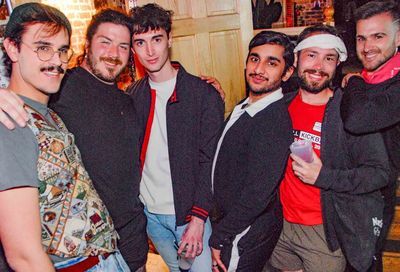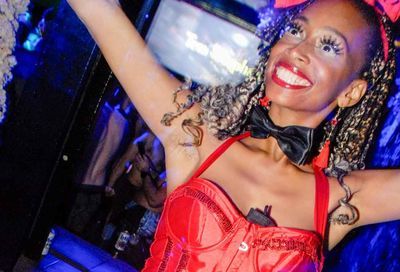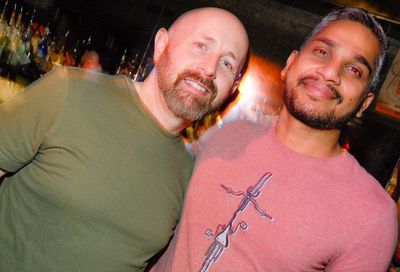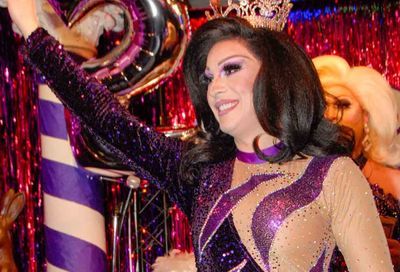Grave Lessons
Learning Curve
I spent my 40th birthday talking to a lesbian ghost. More specifically, I made a pilgrimage to the tomb of famous lesbian author Radclyffe Hall, whose controversial novel The Well of Loneliness became the central lesbian classic of the 20th century.
Published in 1928, the book was instantly banned and vilified in the English press, and it received the same treatment “across the pond” here in America. Obscenity trials painted the novel as dangerous to youth. Though lesbians across many generations found The Well of Loneliness difficult to read for its self-loathing portrait of an outcast “invert” — the heroine, Stephen Gordon, is a rich butch girl forced to leave her family estate — the book’s notoriety ensured that millions of questioning girls smuggled paperback editions home to read at least one testament to lesbian love.
As lesbian scholar Lillian Faderman has pointed out, the book openly raised sociological questions about everything from homophobia to disinheritance to cross-dressing to the role of lesbians in World War I, and thus some of the most enlightened feminist educators and social scientists of the pre-World War II era read and debated the book. But it also trickled down to curious readers of all backgrounds and ethnic identities. In the famous documentary Before Stonewall interviewer Greta Schiller asks African-American lesbian Mabel Hampton about the first lesbian book she ever read. Hampton responds knowingly, “Well, you know how it all started — with The Well of Loneliness.”
Hall herself led a privileged life, called herself “John,” and carried on a passionate relationship with the Lady Una Troubridge. When she died in 1943 she was buried in Highgate Cemetary, the final resting place of many London luminaries. Karl Marx is interred nearby.
Like many a young dyke, I read The Well of Loneliness in my coming-out period — although by the time I was a young dyke there were women’s studies courses and lesbian literary critics promoting and interpreting the book for me. I understood, for all its flaws, that the once-banned book was part of my cultural inheritance as an English-speaking lesbian. Enjoying the post-Stonewall, women’s-music-festival ambiance of my own generation, I preferred more pride-themed (and female-identified) literature. But Radclyffe Hall had an honored place on my bookshelf, which was weighted down with lesbian classics and rare or re-issued novels.
Fast forward to 2001: About to turn forty, I was now a lesbian author myself. My fifth book had just been published, and I had two Lammy nominations to my credit. I pondered a symbolic way to celebrate my important birthday. Because I had always wanted to be a writer and had pursued that dream with some success, I chose to fly to London to sign copies of my own books in the famous literary district of Charing Cross, where Radclyffe Hall, Virginia Woolf and other lesbian writers once walked and sold their work. Because I knew Hall was buried in Highgate Cemetary, I thought it would be the right and decent thing to pay tribute to this “first” author by visiting her grave.
It was a long schlep by underground Tube and a longer walk through a pretty little town, but I finally reached the cemetery gates. There I learned that I had to pay a stiff fee and take an organized tour — no wandering around romantically looking only at the tomb I was after. I was reassured that yes, of course, Hall’s grave was a stop on the tour, so I reluctantly paid my pounds and joined a tourist clump. In fairness to the Highgate management, grave desecrations and the risk of damage or graffiti from vandals can only be avoided by sensible restrictions on all visitors.
I was disgusted, though, when we reached Hall’s tomb and my tour guide completely glossed over Hall’s career as a famous homo. “A controversial writer” was all he said, and made as if to move on. But I put my foot (clad, of course, in a big dyke Birkenstock) down and demanded that our tour group learn a bit more about Hall’s real contribution to the world: her boldness in publishing the first mainstream lesbian novel. I explained that I was a women’s history professor and I could give a brief overview myself if the guide was too embarrassed to do so. To his credit, he let me speak, and added rather touchingly that Hall’s tomb was the most-visited spot in Highgate, with flowers left regularly by lesbian pilgrims like me.
In total violation of tour rules, this man allowed me a few precious moments alone in front of the tomb. I quickly used up a roll of film taking photos of the tomb, the tender inscriptions from Lady Troubridge — “I will but love thee more” — and so on, and made pencil sketches in my art pad as well. Then, as no one was looking, I wrote on a tiny scrap of paper “You are not forgotten!” rolled it to the size of a joint and shoved it through the rusty keyhole into Hall’s tomb.
A rush of cold, cold air blew back at me. I froze. It was a still, warm day with no wind. But I felt the icy blast coming from that other side of the tomb door, as if Hall had meant to say, “Message received at this end, sister.”
I ran screaming to rejoin the tour group; perhaps there’s a reason solo visits to tombs are not permitted. Still, my ghostly encounter was the perfect birthday highlight — an incident I’ll never forget, and I carry the tour-group admission ticket in my wallet to this day. It is all too easy for official tours to leave out the gay and lesbian histories of those people who made our world–and speaking up as I did, perhaps causing our guide to lose face, is a risky gesture, especially when one is a guest in another country. But had I not expressed the bond I felt with Hall, I would have missed two opportunities: the chance to educate a heterosexual tour group about lesbian accomplishment, and the chance to linger intimately with my own literary ancestor.
Bonnie J. Morris, Ph.D., is on the women’s studies faculty at George Washington University and Georgetown University. She can be reached at bmorris@metroweekly.com.
Support Metro Weekly’s Journalism
These are challenging times for news organizations. And yet it’s crucial we stay active and provide vital resources and information to both our local readers and the world. So won’t you please take a moment and consider supporting Metro Weekly with a membership? For as little as $5 a month, you can help ensure Metro Weekly magazine and MetroWeekly.com remain free, viable resources as we provide the best, most diverse, culturally-resonant LGBTQ coverage in both the D.C. region and around the world. Memberships come with exclusive perks and discounts, your own personal digital delivery of each week’s magazine (and an archive), access to our Member's Lounge when it launches this fall, and exclusive members-only items like Metro Weekly Membership Mugs and Tote Bags! Check out all our membership levels here and please join us today!





















